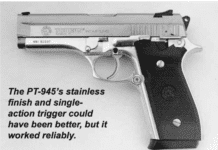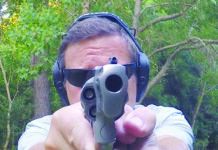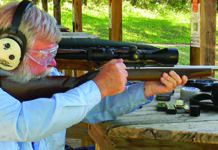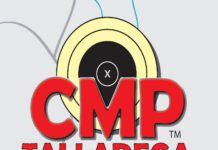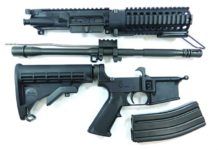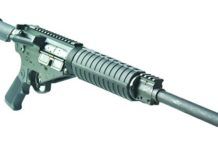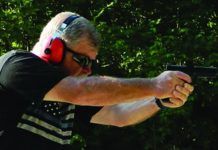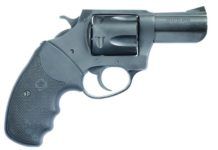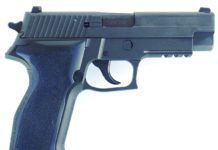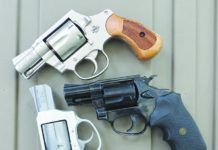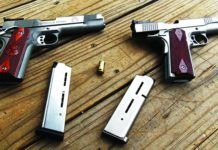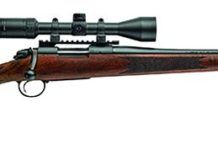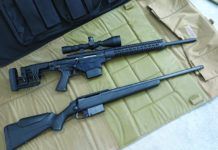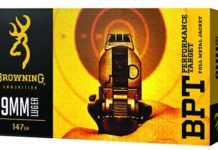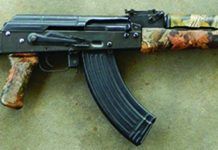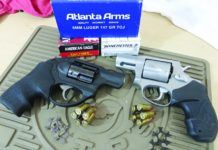Takedown ARs from DRD, Ruger, Windham: Who Takes the Cake?
Espionage novels and movies are filled with rifles that are transported in a brief case, quickly assembled, then used to fire incredibly accurate shots. But is the ability to transport a disassembled AR in a small case or knapsack more intriguing than practical? Couldn't an AR already be considered a takedown rifle? Can't you just disassemble the lower receiver from the upper receiver and tote the two pieces in a duffle bag? These were a few questions team members had as we started looking into takedown AR-15s.
On one side of the debate, a takedown AR can be discreetly carried without the normal gun case that announces to all what is inside. A takedown AR is something one might consider adding to his bug-out gear should flood, fire, or worse coming knocking on the door. Takedown ARs also have the ability to swap calibers, allowing a user to perhaps opt for 300 AAC Blackout on a pig hunt, use the 5.56mm NATO for home defense, and 9mm for low-cost training. This caliber-swap feature gives these ARs the ability to use whatever ammo is available at the moment. We've all experienced the ammunition shortages of the recent past, and there is no reason to think it won't happen again. These ARs can feed whatever ammo is available. Another plus on the takedown AR side is easier cleaning.
On the other side of the debate, parts that are assembled and reassembled wear faster than parts that are fixed, and the more complicated a design, the more likely it is to break and the harder it is to get spare parts. Also, we wondered how zero might shift when removing then replacing the same-caliber barrel? And, how would a different caliber affect point of impact? Of course, price is always a consideration, and the cost of these takedown ARs is high — more than four times the cost of an entry-level 5.56mm AR priced at about $550. Can't a shooter just buy two rifles and set them up with optics at the same cost or less?
To answer these and other questions, we gathered three models from DRD Tactical, Ruger, and Windham Weaponry. These manufacturers have taken the modularity characteristics of the AR to a new level, each offering its own unique takedown design. Operationally, the DRD and Windham are direct-gas-impingement models; the Ruger uses a piston system.
All in, these takedown rifles get smaller by separating the barrel from the rail, which we estimate as a reduction in length of about 8.5 inches. With all three takedown ARs, the rifle is broken down into three main components. One thing to note: The rails or handguards on these rifles are not compatible with aftermarket parts. You must use the handguard the AR is shipped with because it is a key part of the takedown design. You can, however, customize these ARs with other aftermarket parts like stocks, pistol grips, triggers, sights, controls, muzzle devices, and so on.
American AK-Mag Variants II: Century, RRA, CMMG Go At It
Last month, we began testing AK-pattern rifles built in the U.S., which itself is important to a lot of Gun Tests readers, but also because we wanted to take an in-depth look at the category of what we hoped might be "improved" domestic variants of this famous rifle. Over the years, we've admired various AKs for their reliability while we've criticized their accuracy, fit and finish, and shooter-experience packages, such as crappy triggers and uncomfortable stocks. That said, we were very pleased with three rifles we tested in the June issue, rating one as a Grade A gun (Palmetto State Armory AK-47 MOE Edition 7.62x39mm, $749), a second as a Grade A- rifle (Century Arms RAS47 Magpul-Zhukov 7.62x39mm, $800), and the third a B+ (Palmetto State Armory AK-47 Gen2 Classic Red 7.62x39mm, $849).
This time we pit what are probably the two most significant military rifle actions of the 20th century against each other, the Kalashnikov and the Stoner. But there is a twist: All four rifles are American made, are chambered in 7.62x39, and use Kalashnikov-pattern magazines. The two Kalashnikov actions are made by Century Arms and look very much like standard AK-pattern rifles. The two Stoner actions, made by Rock River Arms and CMMG, for the most part look like the AR-15 platform familiar to many shooters but have some unique features. The Kalashnikovs have a well-deserved reputation for reliability, and the Stoners have a well-deserved reputation for accuracy. So, how would they do head to head?
To find out, we fired all four rifles in both cold and hot conditions, and because we expect these rifles to be used both as plinkers and for hunting or rural self defense, we used four different types of ammunition for this test: 122-grain FMJs, 123-grain plastic-tipped hollowpoints, 124-grain soft points, and 154-grain soft points. Due to the fairly big groups shot with open sights at 100 yards last time, this round we fired five-shot groups at 50 yards and measured them from center to center. Here's what we learned.
Glock Night Sights: We Test Glow-in-the-Dark Aiming Aids
As a carry handgun, the Glock is rugged, reliable, and combat worthy. About the only modifications that actually improve the Glock are the addition of a better trigger and a set of aftermarket sights. We dealt extensively with the issue of trigger replacements in the April 2014. There, we installed a Zev Technologies' GlockWorx Ultimate kit from Brownells.com ($250, #100-006-566WB, Mfr. Part: ZTFULULT4G9BLK) into our Glock 17. We gave the Ultimate Kit an A grade, saying it "was the upgrade that produced the biggest difference in performance all by itself, increasing the accuracy of the Glock 17 from an average grouping of 2.3 inches down to 1.6 inches."
Also in the April 2014 issue, we looked at two sight-upgrade kits, both from Brownells. One was the Brownells Glock 17 Sight Upgrade Kit ($200, #080-000-919WB), which included a Meprolight (Kimber) ML-10224 Tru-Dot Night Sight System for Glock 17, 19, 22, 23, 31, 32, 33, 34, 35, 37, 38, 39; an MGW Glock Sight Adjustment Tool, and an Ed Brown Front Sight Tool for Glock. Since we had the installation tools handy, we also ordered a set of TruGlo tritium fiber-optic Brite-Sites ($90, #902-000-107WB, Mfr. Part: TG131GT1Y), yellow rear and green front. We chose to put the TruGlo sights on the Glock 17 and the Tru-Dots on a G34 so that we could shoot them side by side.
With the Ed Brown Front Sight Tool for Glock ($20 sold separately, #087-017-001WB, Mfr. Part: 952) and the MGW Glock Sight Mover ($100 sold separately, #584-045-017WB, Mfr. Part: MGW309) for the rear sight, we started the switch with a disassembly of the slide to get access to the front sight. With the Ed Brown front sight tool and a small crescent wrench, we loosened the screw beneath the sight and removed it, then replaced the white dot with the new TruGlo front sight and tightened with the crescent wrench. Once the front sight was swapped, we hooked the slide into the MGW. The device came with some thin plates to raise the slide up the right height. We did not need them. The old sight drifted out with relative ease, going left to right pointed away from us. The new rear TruGlo sight did require some minor fitting with a file and a little more strength to slide in, but with the MGW tool, leverage was not a problem. We used the same process to put the Meprolite sights onto a factory Glock 34.
Despite the new TruGlo sights being fixed like the originals, we found them to be much clearer and easier to acquire and reacquire targets. We took to the range with the TruGlo sights installed, using all other original parts, and we cut our average group size down by almost half an inch, from 2.3 inches with the standard Glock to 1.9 inches with the TruGlo sights. We turned down the lights over the shooters, leaving the targets illuminated to check out how much the tritium would glow in the fiber-optic sights. The green front sight was quite bright, while the rear yellow sights were significantly dimmer, although still visible.
The Meprolight Tru-Dots provided an even more impressive change on the G34. We shaved just over a full inch off our average group size at 10 yards once we installed them.
Upgrading fixed sights can seem like a challenge to someone who hasn't done work on pistols previously, but with these tools and the simplicity of Glock's designs, this upgrade is a great place to start if you want to attempt a DIY project. You can drift the sights out with a punch, which will save $100 for the MGW tool, but you risk rupturing the tritium capsules. The MGW mover requires oil on the crankshaft, but it made drifting the dovetail sights in and out so easy we quickly misplaced our punch set. Overall, we found the TruGlo sights to be a nice upgrade and would recommend putting them in place of the standard non-tritium sights on any factory Glock. We gave them a Grade: A ranking, along with the Meprolight Tru-Dot tritium.
Naturally, readers asked about other sights, so we began looking at more replacements we could test head to head, rather than as a general Glock upgrade. So, again working with Brownells, we assembled a sextet of night sights suitable for installation on various Glocks. Also, we believe you can broaden our recommendations to include other firearms of similar size — the visual presentation won't be appreciably different on different platforms — though the installation process may differ gun to gun.
Snubbies, the Taurus Recall, and Trump on Guns
Regarding the Taurus settlement and the problems Lou had with his pistol: On August 4, 2015 I sent Taurus my PT-111 Pro and two magazines. Their website was very poor about updating progress of the return, but by 12/16/2015 I did have a new PT-111 G2 with two mags, all new in the box. I had to pay $25 for the FFL transfer fee, but I was reimbursed by 1/15/16. I am actually quite pleased with the new gun. To get reimbursed, I faxed an itemized receipt to Taurus at (305) 624-1126. I hope this helps Lou and perhaps others.
40 S&W Shoot Out: Beretta, CZ-USA, Ruger, and SIG Sauer
Pistols chambered for the 40 S&W round often are the odd man out as the first choice of a citizen contemplating arming himself or herself. Most of us choose the 45 ACP for its terminal performance and the 9mm Luger for capacity. Here, though, this report is in part a continuation of 40-caliber ammunition tests we conducted some years ago. One of our raters has much field experience and favored the 45 ACP and did not give the 40 S&W much attention.
After empirical testing, he came to the conclusion that the 40 is more like the 45 than the 9mm in terminal ballistics, and that's a good place to be. This rater also tested compact and subcompact 40-caliber pistols and came away believing that forties lighter and smaller than the Glock 23 are too much for most shooters to handle well. So, it was logical that he gravitated toward service-size 40 S&W handguns as the right fit of cartridge and pistol.
Full-size handguns are among the most common 40 S&W handguns chosen for home and personal defense. They are relatively mild to fire and reliable.
With these facts in mind, we wanted to test four 40-caliber handguns of different configurations to see which one suited our testers the best. Also, we went looking for value, shooting two brand-new guns against veterans which, perhaps, still had some game left in them. The two new guns were a selective-double-action CZ 75B and the double-action-only Ruger SP40, which we found listing around $580 and $569, respectively. The other choices were the double-action first-shot SIG P226R and the double-action first-shot Beretta 96 Vertec Inox, the latter a used model and the former was a factory rebuild offered by SIG Sauer.
The Beretta Model 96 Vertec has received praise from us before, being named a Gun of the Year in 2005 after being evaluated in the April 2005 issue. We said then, "Alloy 40 S&W pistols have a well-earned reputation for packing plenty of power in their lightweight frames, but they are also well-known for being vicious kickers for the training shooter. However, the Model 96 Vertec was an exception." In particular, we liked the vertical grip design that, combined with the thinner grip panels and short-reach trigger, made the pistol much friendlier to shooters with smaller hands. We liked it because its flat-sided feel and more rectangular shape were easier to index, that is, get in proper alignment faster. This time we tested the stainless version.
Certified Pre-Owned SIG Sauer pistols like the P226R tested here are often traded in by law-enforcement agencies for new SIGs, and the company puts the pre-owned SIG pistols through a stringent Factory Certification process. Each pistol is stripped, refitted with original factory parts where needed, cleaned, lubricated, function tested and hand-inspected by a factory technician. Each Factory Certified pre-owned SIG comes with a one-year warranty and one standard-capacity magazine. The condition of these pistols will vary depending on the amount of wear, such as that caused by a holster and ring wear, and that condition will be reflected in the retail price. Dings and holster wear and ring scratches are not covered under the one-year factory warranty.
We tested a similarly set up CZ 75Bpreviously (May 2009), but chambered in 9mm. In that test we noted the accuracy of the CZ was about 2.5 inches for all shots fired at 15 yards. We also noted the heavy CZ dampened 9mm recoil, and there were no problems with the CZ whatsoever. It appeared to be very well made and built to last. We looked forward to testing the 40 S&W version.
Likewise,we tested a Ruger SR40previously, most recently in the October 2011 issue. In that review, we said, the SR40 was remarkably underrated, and it might be a plastic gun for people who don't like plastic guns. We said, "Its slender profile makes it more controllable than most high-capacity guns, and it's a good candidate for concealed carry, too. We liked having manual safeties even if they weren't perfect. Though not match grade, we thought the trigger was predictable with a reasonable sense of take-up and overtravel." That model was the BSR40, with an all-black color scheme and a 15+1 capacity, which is now listed by the company as Model 3471. This new SR40 is Model 3470, still with the same 15+1 capacity, but this time with a brushed-stainless-steel slide.
$400 Snubnose Revolvers: Rossi, RIA, and Charter Arms
We felt all of these were well made, and we believe these revolvers will perform their designed task of self defense. They are also safe to carry fully loaded and concealed, since they are equipped with internal safety systems that require the trigger to be pulled fully to the rear to fire a round. If accidentally dropped, none of them will fire.
Snubnose revolvers like these three offer the user simplicity since there are no manual safeties, magazine-release buttons, slide stops or any other controls on the revolver other that the cycler latch. There is no magazine to lose since the revolver feeds off an attached cylinder. The double-action trigger pull on all three revolvers provided enough resistance — some were easier to press than others — so that in a high-stress situation, we felt they would be quite adequate and be less likely to be accidentally discharged.
All were metal-frame revolvers chambered in 38 Special and sported 2-inch barrels. The Rossi and Charter Arms models have 5-round capacities, while the RIA can carry 6 rounds. Because we also wanted to carry these revolvers, we looked at spurless and concealed-hammer models, which were the RIA and Charter Arms, respectively. The Rossi was a traditional SA/DA revolver with an exposed hammer with spur.
After running these revolvers, we found we liked a lot about all of them, but, as always, we noted some specific details about them we did not like. Our biggest gripes were the trigger pulls and grips, as we note below. Accuracy with some of these short-barrel protectors was a pleasant surprise.
All three were marked 38 Special, and we read the manuals to see if the guns were safe to use +P ammo. The Rossi manual stated it was compatible with +P ammo, but not to use +P frequently. We decided to test with 38 Special regular-pressure ammunition only, and acquired some Federal Champion 158-grain lead roundnose (LRN) cartridges, some Armscor 158-grain Full Metal Jacket (FMJ) rounds, and Hornady Custom fodder loaded with 158-grain XTP hollowpoints. Felt recoil with this ammunition varied widely.
A $400 revolver will exhibit some characteristics, such as fit and finish, that are not going to be nearly as nice as a revolver costing twice as much because finishing a firearm can be labor intensive and costly. What we concentrated on were the functional aspects: triggers, sights, grips, accuracy, concealability, and ease of use. Here is what we discovered.
Practical Target Guns: Kimber And Springfield Go Head to Head
In this installment, we pit two practical target guns against each other. By practical target guns we mean accurate and useful 1911 handguns suitable for personal defense, hunting, and some forms of competition. They are not so specialized that they are not holster guns or unreliable for general use. Some target guns simply are not as robust as these handguns.
Fragile sights that overhang the slide too far, as an example, are counterintuitive in an all-round packing gun. If an adjustable sight loses its zero in competition, you will lose the match. Losing zero in a personal-defense situation carries a stiffer penalty for failure. Getting down to the nitty-gritty, fiber-optic front sights are not always desirable in a hard-use handgun because they tend to be fragile, even if they deliver superior targeting performance.
On the other hand, a service pistol or a hunting pistol with adjustable sights is desirable given the wide range of bullet weights and velocity available with the 45 ACP cartridge.Gun Testsreaders already know that the 1911 Government Model platform is a versatile, go-anywhere do-anything handgun; but the question is, can target performance translate to defensive reliability and handling?
When the National Matches got into full force after World War One, improvements were undertaken on the 1911 handgun. Barrels were welded up and carefully fitted, and high-profile sights were fabricated. These improvements led to the Colt National Match pistol's introduction in 1933. The National Match featured a hand-honed action and two-way adjustable sights. Law officers and outdoorsmen also adopted this relatively expensive handgun. Changes and modification led to the Colt Gold Cup. The sights were fragile in many renditions — not the case in the newest models — so the shooter wishing to own a service-grade handgun with target sights had to take the custom route. Expedients, such as fitting Smith & Wesson revolver sights to the 1911 slide, were not always successful, but the Bo-Mar sight was an excellent addition to any 1911.
High-visibility adjustable sights are a good thing to have, provided they are reliable in keeping zero, are not fragile, and aren't likely to be damaged. Today, we have the best adjustable-sight 1911 pistols yet from the factory, and our two tests guns put them to excellent use. Here's how they performed.
New Long Guns Coming for 2016
At the 2016 SHOT Show in Las Vegas, Gun Tests staffers ran across many dozens of new products that we're working to include in future tests. Following are some of the rifles, rifle ammunition, shotguns, and long-gun accessories we found interesting. If there's something in particular you want us to test, please drop me a note at GunTestsEditor@icloud.com.
Barnes Bullets has added two new loads to the VOR-TX line of premium ammunition. The first is a 130-grain Tipped Triple Shock load for the 308 Winchester. It is rated at 3,170 fps, and it takes the 308 Winchester into a new realm of velocity. SRP: $45.69 for a 20-round box. The second load is an 190-grain LRX bullet for the 300 Winchester Magnum. This bullet's ogive and cannelure design gives it a high B.C., and the nose cavity engineering ensures it expands reliably at lower velocities. It is rated at 2,860 fps.
The Woodsman rifle is new from Bergara. This bolt-action hunting rifle weighs 7.4 pounds in long action and 7.1 pounds in short action. It has a hinged floor plate and comes with a 22- or 24-inch, No. 3 contour barrel. The stock is American walnut, and available chamberings include 6.5 Creedmoor, 7mm Rem. Mag., 308 Win., 30/06, and 300 Win. Mag.
Browning's biggest shotgun news is that the Sweet Sixteen is back. Like its most revered predecessor, the new A5 Sweet Sixteen is built on a smaller, lighter receiver for reduced weight and a sleek feel. The A5 uses kinetic energy to power the recoil-operated Kinematic Drive System for reliable function with any load and under the full extremes of weather, temperature, moisture, or grime. The A5 16-gauge receiver is constructed of aluminum with a black anodized bi-tone finish. The stock—shim-adjustable for length of pull, cast, and drop—and forearm are gloss finish walnut with a close-radius pistol grip and sharp 18 lines-per-inch checkering. The gun uses Browning's Invector DS choke system; three chokes will be supplied with 2 -inch chambered barrels in 26- or 28-inch lengths. Weight: 5 pounds 12 ounces.
308 Win. Bolt Guns: Rugers Precision Rifle vs. Tikka T3 CTR
We admire long-range competitive shooters for doing something we mere shooting mortals find nearly impossible. Their ability to manage distance, wind, and overly complicated reticles on specialized rifles to deliver hits on targets that can hardly be seen with the naked eye is both an art and science. Usually a precision centerfire rifle is custom-made, costing upwards of $3,000 or more with a wait time that can take years, depending on the popularity of the custom-rifle builder. Adding a suitable optic can increase the cost an additional $1,000 to $2,000, plus bipod and other pieces of gear, not to mention quality ammo. All in, a shooter could easily sink $7,000 into a set up before even sending a single piece of lead downrange.
Firearm manufacturers, seeing the shooting public's interest in long-range shooting, are offering rifles advertised as "tactical" and "precision" to attract long-range hunters and weekend paper punchers. We all know that setting a barreled action in a black polymer stock does not make a precision rifle. But lately, some large firearm manufacturers have begun mass-producing accurate rifles that rival some custom-built rifles without the wait or the high cost. These mass-produced precision rifles can handle many long-range chores, and some of them come in compact lengths and have the ability to add muzzle devices, such as suppressors.
We wanted to take a look at a few of these rifles to get a sense of their accuracy as well as their consistency, ease of use, ability to be customized, and cost. We began looking at such rifles in the January 2016 issue when we compared three bolt actions from Savage, Ruger, and Howa, all chambered in the very accurate 6.5 Creedmoor round. Our favorite in that test was the Savage Arms Model 12 Long Range Precision 19137, followed by the Ruger Precision Rifle 18005 and the Howa HB HKF92507KH+AB. Here we take a second look at the Ruger Precision rifle, this time in 308 Winchester, against a Tikka T3 CTR. The 308 Win. is a common and popular round, with many factory ammunition options available. We tried the spectrum of 308 Win. ammunition and bullet weights, from inexpensive Sellier & Bellot 150-grain soft-point hunting rounds and Norma USA's 168-grain Sierra hollowpoint boattail to expensive 175-grain boattail Sierra MatchKing hollowpoints in the Federal Premium Gold Medal match ammo line, as well as Hornady 155-grain TAP FPDs. Both rifles were fired from a sandbag rest as well as from seated and prone positions. We also made sure the temperature, wind speed, and humidity conditions were similar when we shot these rifles, even though these factors have more affect on targets at farther distances than the distance tested. Barrels were allowed to cool after each string.
Test firing was conducted at 100 yards, though that distance may seem short compared to what these rifles' makers say the products can do. This is the most common rifle-range distance many shooters have access to. Members of this particular test team had experience with high-end SIG Sauer SSG 3000 and Sako TRG M10 and TRG 42 rifles, and numerous chassis-style rifles with Remington, Savage, and custom-rifle-maker barreled actions, as well as long-range hunting rifles like the Savage 11/111 models and Remington Model 700 varmint rifles. A Leupold Mark 4 4.5-14x50mm LR/T scope (Brownells.com, $900, #526-000-150WB) was moved between rifles Warne Maxima-series steel rings to ensure there was no optic variability. The Mark 4 series has been used by the U.S. Marine Corps on the M14 rifle and with the U.S. Army's M24 sniper weapon system. One might consider it to be a benchmark in tactical scopes. It is made with a one-piece 30mm tube and a 50mm objective. The M1 TMR (Tactical Milling Reticle) reticle is located in the second focal plane, so it stays one size even as the magnification power is increased. To use the Mil-Dot ranging features, the scope must be set to the highest magnification. We bore-sighted the rifles prior to starting range work. Here's what our shooters found out at the range.
New Handguns at SHOT Las Vegas 2016
At the 2016 SHOT Show in Las Vegas, Gun Testsstaffers ran across many dozens of new products that we're working to include in future tests. Following are some of the handguns, handgun ammunition, and handgun accessories we were interested in. Next month we'll look at new long guns and new options for them.
Given the growth of the AR-15 pistol market, aftermarket supplier ATI sees an opportunity to help users of the popular Ruger Charger get more enjoyment out of its use. The AR-22 Pistol Stock System features a polymer receiver chassis and a T2 pistol grip as well as a six-sided aluminum free-floating forend that sports an FS8 nose cone. The T2-style pistol grip lowers a shooter's hand to align the finger with the trigger, and the sure-grip texture helps reduce recoil. In addition, the stock also features a 16-inch aluminum Picatinny rail that runs the length of the receiver and forend for trouble-free optic and accessory mounting.
The biggest ammunition surprise might be the news that Browning is now offering, via licensing, a full line of ammunition manufactured by Olin-Winchester.
The BXP Personal Defense X-Point defensive handgun loads are loaded in black nickel-plated cases, with bullets utilizing the X-Point technology. There is also a line of Target Performance BPT loads for defensive handguns. The usual chamberings are represented in both lines, with one load each in 380 ACP, 9mm Luger, 40 S&W, and 45 Auto. Browning is also offering rimfire loads in 22 LR. They have a distinct black-oxide coating on the bullet and will be offered in 100- and 400-round packages.
AK-47 Accuracy
Recently, a Gun Tests reader requested that we gauge the accuracy of 7.62x39mm loads in the AK-47 rifle, with an eye toward evaluating the AK for ad hoc hunting, if the opportunity arose. Many of these rifles are in use in America, so determining the ability of the rifle to humanely harvest a deer or hog seemed like a good idea to check out. The 7.62x39mm cartridge is often compared to the 30-30 Winchester in power, and if the AK-47 and its loads were accurate enough, then the pair could be counted upon to take thin-skinned game at moderate distance.
The question is, how accurate is commonly available ammunition in an average AK-47 at 100 yards? To find out, we obtained an AK-47 from the used rack at a pawn shop. The rifle featured an NDS receiver and seemed well put together. While we were there, we also grabbed an SKS chambered for the same round, in this case a Chinese rifle in excellent condition with matching serial numbers on its parts.
Benchresting the AK and its long magazine produced some difficulties. We found it is not an easy rifle from which to coax accuracy. The SKS was easier to use well off the bench, especially when using the onboard iron sights. After initial sighting work at 50 yards to get on the paper, we fired a succession of three-shot groups at 100 yards, sighting both at the base of an 8-inch bull. At the end, we found the SKS to be slightly more accurate with the ammo we selected.
In broad terms, then, we think most shooters can get commonly available AK-47s to shoot around 4-inch groups at 100 yards, good enough to take game at that distance. We had slightly better results with the SKS, and would think of it as a 3.5-inch gun at that range. Also, we found a few rounds these guns preferred, so if you're attempting to knock a hog in the head, you might consider starting with our winners in your own AK or SKS. Following are our ratings for eight ammunition choices suitable for the AK-47 or SKS variants, and you can also scan the results in the accompanying table.
9mm Luger Snubnose Revolvers: Ruger LCR versus Taurus 905
The 9mm is the most popular handgun cartridge in the world, in use with most military forces and LE agencies; in fact the FBI announced in 2014 that it is switching back to the 9mm after having used the 40 S&W since 1997. When we think snubnose revolvers, we typically think 38 Special, but since the mid-20th century, revolver manufacturers have been building short-barreled wheelguns chambered for 9mm semi-automatic pistol ammunition. In the past we tested two such 9mm Luger chamberings, an S&W Model 940 (C+) and Charter Arms Pitbull (A-). We noted then that 9mm compact semi-automatic pistols have an edge over 38 Special revolvers due to the semi-automatic's higher round capacity, but in the revolver, the playing field between 38 Special and 9mm Luger is leveled, as far as round counts go.
Now, ballistic technology has made the once underperforming 9mm better. We have done a number of tests comparing 9mm and 38 Special ammunition from short-barrel handguns, and, generally speaking, the 38 Special runs bullets with weights from 110 to 158 grains at muzzle velocities of 900 fps to 1000 fps. The typical 9mm uses bullet weights from 115 to 147 grains at speeds of 910 fps to 1100 fps. So the 9mm has a slight performance advantage over the 38 Special. A bigger nod goes to the availability and affordability of 9mm ammo, which can be found nearly anywhere in the world, and which domestically costs about 17 cents a round compared to 25 cents a round for 38 Special.
There are other reasons to look at 9mms in wheelguns. We feel the ability to swap ammo between our semi-auto and our revolver makes sense, with only one type of cartridge to purchase. New shooters usually find revolvers to be less complicated to operate, so if your home-defense backup isn't familiar with semi-autos, you can still partner a high-cap 9mm semi-auto with a low-cap 9mm wheelgun pretty easily.
Though some testers groaned when they saw the 9mm revolvers in this test, saying they were as unnatural as three-wheel motorcycles, they put their prejudices aside and found these revolvers performed well at the range. The Ruger LCR Model 5456 9mm Luger debuted in 2014, and the Taurus 905 has been around since 2003. Unlike the Charter Arms Pitbull (which does not use moon clips, but instead employs a retention spring built into the ejector that fits under the 9mm cartridge's rim), the LCR 9mm and the 905, like the S&W Model 940, use five-shot moon clips. Moon clips have been the standard convention when chambering semi-automatic cartridges in revolvers since 1917, when 45 ACP was chambered in S&W and Colt's large-frame revolvers. Moon clips mean the revolver is fast to reload — nearly as fast as a magazine change in semi-auto. But, as we have found in the past, carrying a spare moon clip in one's pocket can lead to bent clips, making them inoperable. Not that this a show stopper, just an attribute of moon clips in general. So don't put a moon clip in your rear pants pocket and sit down. In fact we loaded both the Ruger and Taurus moon clips provided with the test guns and dropped them onto a concrete floor from waist height to see if the cartridges would fall out or the clips bend. A cartridge from each clip popped out after the drop, but there was no sign of bending. Another cost we looked at was how much moon clips go for.Brownells.comlists three moon clips for $12.99 (#780-001-371WB), less than one semi-auto magazine. The moon clips from Taurus and Ruger were not compatible with the other manufacturer's revolver. We should note that single cartridges can be loaded into the chambers of the Ruger and Taurus wheelguns and fired safely, since the 9mm case headspaces on a step in the chambers. In that case however, extraction without a moonclip requires each case be pushed out with a pencil, pen, or similar skinny object.




